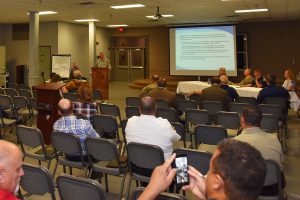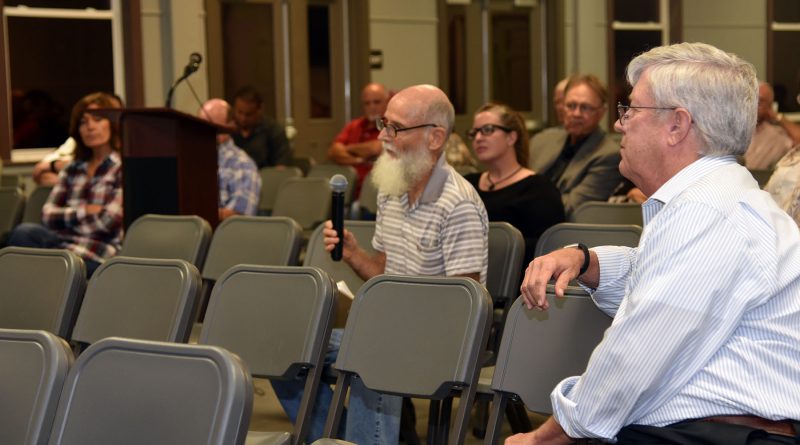Explosives experts: CBI must be destroyed ‘in-place’
1st Lt. Rebekah Malone, Louisiana National Guard Public Affairs Office
 MINDEN, La. – A public town hall meeting was held at Camp Minden in Minden, to provide an update on the disposal process of Clean Burning Ignitor (CBI), Oct. 13. The Environmental Protection Agency, Louisiana Department of Environmental Quality, Louisiana Military Department and Louisiana State Police provided the update.
MINDEN, La. – A public town hall meeting was held at Camp Minden in Minden, to provide an update on the disposal process of Clean Burning Ignitor (CBI), Oct. 13. The Environmental Protection Agency, Louisiana Department of Environmental Quality, Louisiana Military Department and Louisiana State Police provided the update.
The agencies have held numerous meetings since the Sept. 29 auto-ignition of approximately 120,960 pounds of CBI located in a storage magazine in what is known as L2 on the eastern boundary of Camp Minden. The magazine was totally destroyed.
Following the auto-ignition, the Army’s Environment Safety Board advised the Louisiana Military Department to call an explosives ordinance team from Fort Polk to survey and destroy any unburned CBI that may still be in the area. On Sept. 30, the EOD team discovered three boxes of approximately 100 pounds of CBI and destroyed it in place.
On Oct. 4-5, the Army’s Explosive Safety Technical Assistance Visit (TAV) team arrived at Camp Minden and began an assessment of how to address the approximately 200,000 pounds of remaining CBI in three magazines. One magazine also contains 40,000 pounds of M6 propellant.
The TAV team determined that the remaining CBI is too dangerous to handle and advised this situation be treated as an emergency.
“The TAV team made a comprehensive review of explosives safety issues related to the continued storage of the remaining CBI and M6,” Eugene Collins, deputy assistance Secretary of the Army for Environment, Safety and Occupational Health wrote in a letter to Carl Edlund, director of the Superfund Division Environmental Protection Agency, Oct. 11.
“The team’s primary focus was on ensuring the recommendations it made for EPA’s consideration focused on actions that would reduce or mitigate potential explosive hazards to LMD personnel and public safety,” wrote Collins.
The report advised that the disposal of the CBI stored in magazines 505, 2432 and 2471 should be considered an emergency and must be immediately addressed. The TAV advised the CBI be destroyed in place with the support of EOD.
The TAV further advised magazines 2432 and 2471 should be remotely ignited because the risk of entering the magazine to remove the content for destruction is not acceptable. Many other recommendations on the schedule, times, air monitoring, communication with the public and special precautions to manage fires were also presented.
The EPA and LDEQ will work collaboratively to conduct environmental sampling and monitoring. Air samples will be collected at four sites and analyzed for total particulates, dioxin/furans (D/F) and Semi-Volatile Organic Compounds (SVOCs) to include the primary three chemicals of interest (Diphenylamine, Dinitrotoluen and Dibutylphalate). Results will be available within 30-days of sampling. Soil sampling will be conducted as part of LMD’s closure plan.
The Trace Atmospheric Gas Analyzers (TAGA) bus will also be used to conduct real time monitoring of air for the chemicals of interest.
“The TAGA will drive around in the community and do real time monitoring for two of the compounds and let me know immediately and get that word out to the community if there are any concerns,” Adam Adams, of the EPA said. “We do not expect any concerns.”
community if there are any concerns,” Adam Adams, of the EPA said. “We do not expect any concerns.”
The Louisiana State Police’s Emergency Services Unit will also work with state and federal partners to ensure the safe mitigation and remediation of all explosive materials.
“The ESU’s goal is to ensure that the citizens of Louisiana are not exposed to any undue risk of hazardous materials or explosives through education, strict enforcement of the law and regulations governing the manufacturing, handling, using, storing or transportation of hazardous materials and explosives,” said Louisiana State Trooper Jay Hardy. “… ESU will work with state and federal partners to ensure the safe mitigation and remediation of all explosive materials.”
Prior to each in-place destruction, the public will be informed and additional safety instructions released. The first magazine that contains 820 pounds of CBI will be destroyed once conditions are set approximately October 17-20.
All partners reminded those gathered during the town hall that the safety of the community and the contractors is and will continue to be a top priority.
“Our position is that we are moving forward with the recommended options so that we can safely, efficiently and effectively dispose of the CBI,” said Maj. Gen. Glenn Curtis. “Safety is paramount and remains my priority. We will continue to communicate with our community and partners as we work through this process.”
Explosives Services International is the contractor working to destroy the 15 million pounds of M6 propellant and 320,000 total pounds of CBI that was illegally stored by Explo Services, Inc., in 2012. ESI was not working in the L1 area at the time of the auto-ignition and no injuries were reported. ESI has continued to safely destroy M6 that has been moved from magazines outside the contained area. To date, 6.8 million pounds of M6 has been destroyed.

